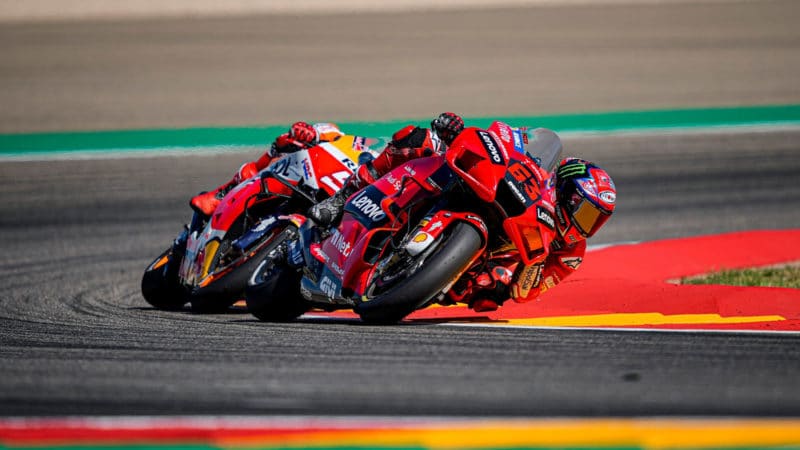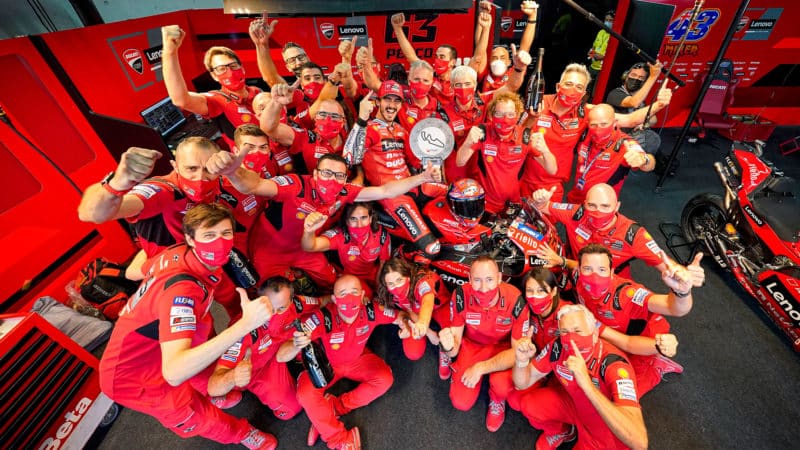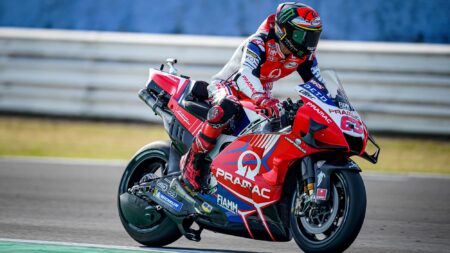Bagnaia’s strength came from getting the bike stopped incredibly quickly in the middle of the braking zone, so he comes off the brakes and gets the bike settled before zooming into the corner with huge speed.
Of course, relying on the front tyre for your speed is always risky – especially in the Michelin era – and even last year he hadn’t got his technique fully sorted. Bagnaia crashed out of three races, often because his smooth, gliding style wasn’t getting enough heat into the front tyre from the start.
And he missed three races after falling during Czech GP practice and breaking a leg.
Last winter he focused on getting heat into the front tyre by training to use the tyre at its maximum from the moment he exited the pits. A treacherous trick to pull off.
“Riders need time,” explained the first-time MotoGP winner, who to me looks to me more like a philosophy student from Turin University than a motorbike racer. “I struggled a lot in my first year and last year I wasn’t so fast sometimes and often I was crashing in a straight line.
“This year I’m fast but still I lost some possibilities to win before. At Portimao I found a yellow flag in qualifying [which put him way back on the grid] and I crashed at Mugello, so every time I was missing something.”
He also fought for victory in the Austrian GP, until the rain arrived, and was a race favourite at Silverstone until he got a dud rear tyre.
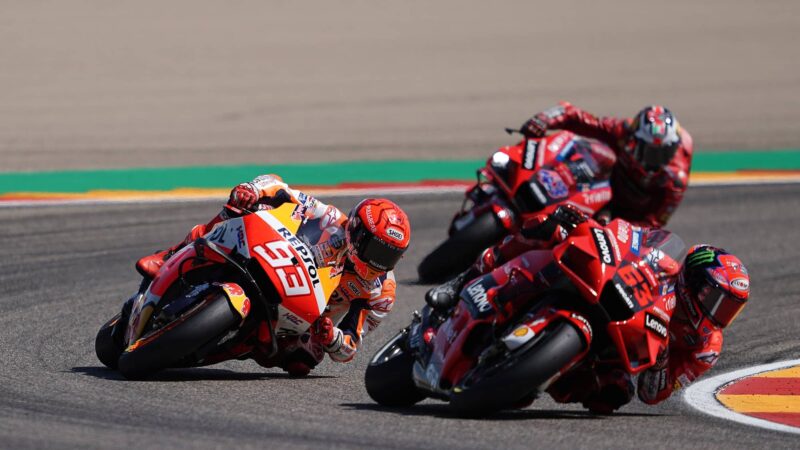
Jack Miller stayed with the leaders for while
Honda
There’s no one better to explain Bagnaia’s strengths than Márquez who, on Sunday afternoon, spent 41 minutes examining his every move.
“I tried to analyse his weak points but he didn’t have any – he was fast everywhere,” said Márquez. “I have fought many times with Andrea Dovizioso on the Ducati – Pecco was the same but with more corner speed.”
In other words it seems like Ducati may have found its chosen one for the first time since it failed to keep hold of Jorge Lorenzo at the end of 2018.
By the way, Lorenzo put the Ducati on pole at Aragon in September 2018, just as Bagnaia did on Saturday. And Lorenzo managed to coax some of the same corner speed out of the usually unwilling Desmosedici just as Bagnaia does.
Of course, this isn’t all Bagnaia’s own work, it’s also the work of Ducati engineers who for years have burned the midnight oil, trying to exorcise the bike’s mid-corner weak point.
Bagnaia’s team-mate Jack Miller explained during Aragon practice that the difference between the 2020 bike and the 2021 bike is huge, especially through long, sweeping turns like Turn Ten (the long left after the Corkscrew) and Turn 16, the fast, double apex left at the end of the main straight, where riders need to get the bike turned, so they can lift it up onto the fatter part of the rear tyre and fully unleash its horsepower.
“You really notice the difference through those corners where you’re a long time on lean angle,” said the Australian, who finished fifth on Sunday, 11 seconds down, after a technical issue caused him to run off the track. “When you’re trying to keep a neutral position on the gas, or slowly wind it on, the bike turns more, whereas before you’d roll off the edge of the tyre or start to go wide.”
Obviously the Ducati’s top-speed superiority played its part in Bagnaia’s Aragon win – on the occasion of the 50th anniversary of the company’s first premier-class grand prix at Monza on 12th September 1971 – just as it played a part in the company’s previous 54 victories.
Ever since Ducati arrived in MotoGP in 2003 it has prioritised top speed like no other manufacturer, not only through engine performance but also through aerodynamics, by hiring Formula 1 aerodynamicist Alan Jenkins to make the Desmosedici more slippery than its rivals.
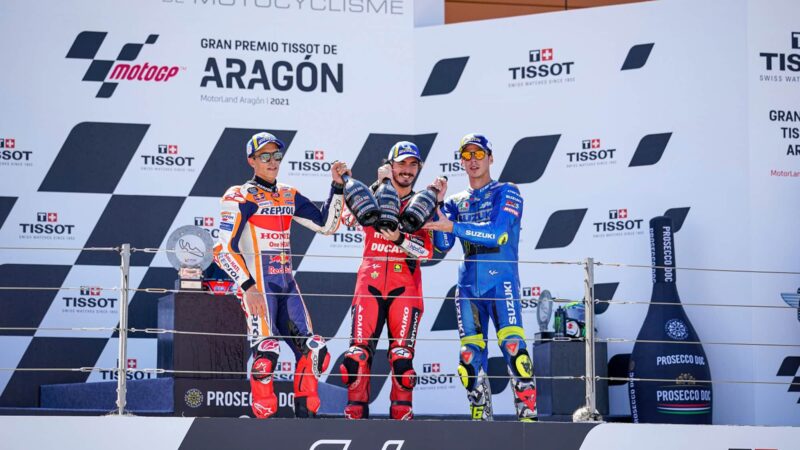
Joan Mir fully deserved the last place on the podium
Suzuki
This is a big deal for two reasons. First, straight-line speed is free time for the rider – if he can make time on the straights. he can stress himself less and also stress the tyres less, which means he can manage grip better over race distance. Second, overtaking in a straight line is very easy, while overtaking in a corner is very difficult and gets more so every year.
The numbers are astonishing. Over the last eight MotoGP seasons the Ducati has been the fastest bike at 107 MotoGP rounds, while Honda’s RC213V has been quickest at 23 races, Yamaha’s YZR-M1 at five and KTM’s RC16 at two. And an inline-four hasn’t topped the speed charts since Motegi 2018, underlying once again the efficiency of the V4 configuration.
Ducati’s reign as MotoGP’s undisputed top-speed king doesn’t happen because none of the other factories are too bothered about top speed, it happens because Ducati can squeeze more brute power from its desmodromic-valve V4 than Aprilia, Honda and KTM can squeeze from their pneumatic-valve-spring V4s.
A desmo engine differs from most engines by using cams and actuators to open and close the valves, rather than relying on springs (pneumatic or metal) to close the valves. As rpm increases this becomes more and more important, as issues such as valve float and so on prevent a valve-spring engine from creating maximum power.
Thus Ducati always has an advantage with engine performance, with its current MotoGP engine making around 300 horsepower. Ducati’s rivals manage mostly to overcome the desmo’s straight-line advantage by finding their lap times elsewhere, but if Ducati now has a bike and a rider than can match the others through the corners then its rivals may find themselves in trouble.
And next year there should be eight Desmosedicis on the grid – a third of all entries – so what will happen to other riders when they find themselves boxed in by a bunch of desmos?
In fact it’s not only the Duke’s brute power that makes it accelerate so fast. Ducati started the whole shapeshifter weapons race at the end of 2018. This technology is under constant development and there’s little doubt that Ducati still leads the way, which gives its riders even more free speed exiting corners.
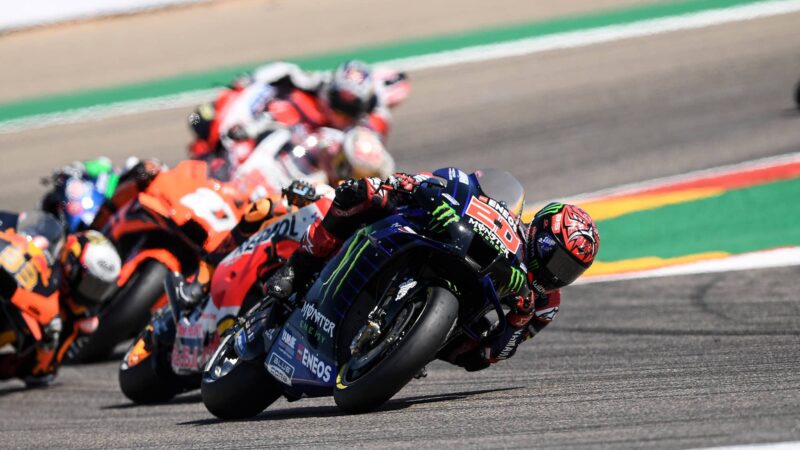
Title leader Fabio Quartararo spent much of the race getting away from more powerful V4s
Yamaha
World champion Joan Mir never got close to the leaders on Sunday, but his ride to third was mightily impressive. He managed to avoid getting mixed up with the faster V4s, so he could exploit the GSX-RR’s super cornering performance up and down the Aragon hill. At the finish he was only 2.3 seconds behind Marquez.
Suzuki was the last factory to receive a shapeshifter – which lowers the bike exiting turns to reduce wheelies and therefore improve acceleration – and used it with great success at both Red Bull Ring races but removed the gadget for Silverstone because the circuit layout doesn’t require it.
Suzuki tried again at Aragon but Mir removed the device after Friday, because it was interfering with braking.
Unlike Mir, championship leader Fabio Quartararo and his Yamaha YZR-M1 did get swallowed up by the V4s. Sunday was only the Frenchman’s fifth time off the podium all year and his worst result, except for Jerez, where he was slowed by arm-pump problems.
He spent much of the race just inside the top ten, sometimes battling with the KTMs of Iker Lecuona and Brad Binder, other times with the Ducatis of rookies Enea Bastianini and Jorge Martin.
But in fact it wasn’t so much an inline-four-versus-V4 thing. This time, it seems, it was Quartararo’s chance to get a dud tyre, just as title rivals Mir and Bagnaia had two weeks earlier at Silverstone.
“From the beginning of the race I felt like my rear wasn’t working normally, so I went down, down, down,” he said. “From the first lap it seemed like my rear tyre was different, with a weird feeling from the first lap to the end. I didn’t have stopping performance, nor grip, nor traction.
“Also this track is quite a mess for us because from Turn 15 to Turn One [the back and front straights, plus Turn 16] we lose three or four tenths of a second, which I need to recover in the corners, which is difficult.”
Misano next, where Bagnaia was incredibly fast last year (until he crashed) and both races were won by Yamahas.
Five races left and 53 points between Quartararo and Bagnaia – nothing is impossible just yet.

